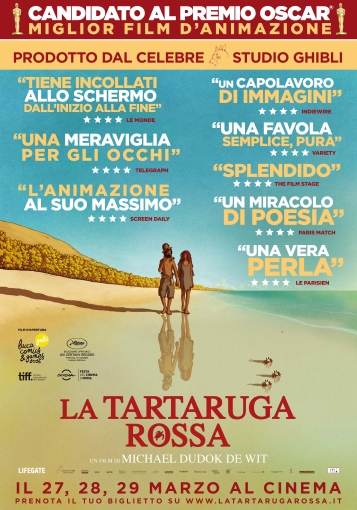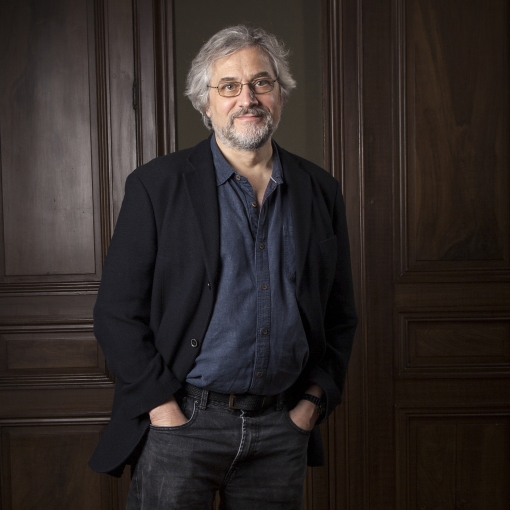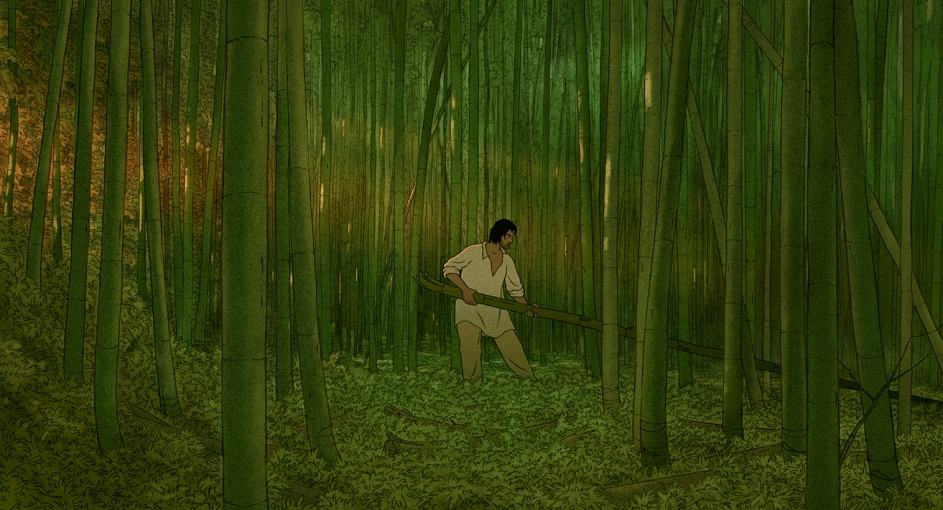The red turtle - The animated film

Through the story of a castaway on a deserted tropical island populated by turtles, crabs and birds, The Red Turtle tells the great stages in the life of a human being.
A castaway on a desert island tries desperately to escape, until one day he meets a strange turtle that will change his life.
INTERVIEW WITH DIRECTOR MICHAEL DUDOK DE WIT

Director Michael Dudok de Wit
Among your animated shorts, at least two have become "cult". In 1996, The Monk and the Fish, made in the Folimage studio in Valenza, received a Ce´sar and an Oscar nomination. Then it was the turn of Father and Daughter which, in 2001, was welcomed by an avalanche of important awards (Annecy, Hiroshima etc.) and an Oscar. A little girl sees her father disappear and the memory of the parent will accompany her throughout her life. In this theme you express a sentiment that is difficult to define: the "yearning" ...
Yes, it's a difficult feeling to define because it's subtle, but I think many people know it. It is an aspiration towards something that seems inaccessible, a great silent and profound desire. For an artist, it can mean a desire for perfection, for an ideal in music, in drawing, in poetry ... It is a painful yet very beautiful lack. You cannot imagine how many very touching testimonies I have received from friends and even strangers. They said the film tells them about events they have experienced themselves. I was very lucky, it became a classic.
In 2004, you served on the jury at the Hiroshima Festival. Was it on that occasion that you met Isao Takahata?
In fact, we had a short exchange, he even spoke to me a few words in French. He loves French culture. And a short time later, while I was at the Seoul Festival where I was giving a lecture on my work in front of an audience of students, I was surprised to see him arrive with a translator. I thought he just came to say hello but no, he attended the whole conference! Perhaps he was already thinking of a professional collaboration?

Then, in November 2006, you unexpectedly get an email from Tokyo.
With two questions. In the first one, the Ghibli museum asked me if I would agree that Father and Daughter would be distributed in Japan. In the second, if I was interested in working with their studio on a feature film of my own conception ... Up until that moment I had never really thought about the feature film. Some friends of mine, to whom wonderful promises had been made, had left for California and returned disappointed after seeing their projects reworked by the producers.
But with the Studio Ghibli it's different. They told me that we would work under French law, therefore respecting copyright. They gave me several months to write the script. I was cultivating the seed of the theme of a man on a desert island, which in the meantime had become omnipresent on television, but it was an archetypal concept that I still liked. But I didn't want to tell how a castaway manages to survive, an aspect that has already been treated dozens of times. I needed something more. For this reason I stayed on a small island in the Seychelles archipelago, a name synonymous with luxury holidays, making a simpler choice, staying for ten days at the home of a local. I went for a walk alone, looked around and took thousands of photos. I absolutely wanted to avoid the "holiday village brochure" look. My castaway does not have to fall in love with the place, he wants to go home at all costs, because the island is not so welcoming, it presents dangers, it imposes a condition of extreme solitude, it rains, there are insects ...
I made the classic mistake: my script was too detailed and the film would have been too long. But the basis of the story was good. In the next phase, that of the animatic, that is the very simplified version of the film drawn with still images, without movements, I discovered that in some points it would not be easy to translate the story into a cinematographic language. There were knots left that I couldn't untie. Then Pascal Caucheteux, the producer of Why Not Productions, offered me to meet Pascale Ferran. Over the course of several months, we saw each other regularly and discussed in depth the film as a whole, as it was impossible to change isolated elements without affecting everything else. Pascale helped me identify the critical issues and make the narrative clearer and more incisive. Furthermore, he is very fond of the idea that in animated films the editing is well thought out before the construction of the frames and has offered numerous and valid contributions to the editing phase.
One of the themes is once again the "yearning", this waiting for the hero in front of the sea ... But also the one that you who is timeless, the "out of time". It is present in all your films, we perceive it in the sequences on the trees, the sky, the clouds, the birds that circle ...
Yes, they are moments of great purity and simplicity, which each of us knows. There is neither the past nor the future, time no longer exists.
But time is also circular. Generations follow one another. The child performs the same gestures as his father, overcomes the same rocks, undergoes the same dangers. In animals the cycle is different: the dead fish feeds the flies that are eaten by the spider, the crab is carried away by the bird and so on ...
Exact. The film tells the story in a linear and circular way and uses time to talk about the absence of time, a bit like music can highlight silence. It is a film that also tells that death is a reality. The human being tends to fight death, to be afraid of it, to fight to clear it and this is a very healthy and natural attitude. Yet you can have at the same time a beautiful intuitive understanding that we are pure life and do not need to oppose death. I hope the film conveys this feeling a bit.

Another essential element is the appearance of the turtle, its mysterious side ...
The idea of creating a story with a large turtle came quite quickly. We needed to have an impressive and respected ocean creature. The sea turtle is solitary and peaceful and for long periods disappears in the immensity of the ocean. It gives the feeling of being close to immortality. Its deep red color suits it and stands out visually. We have long thought about keeping a certain level of mystery in the story. In the films of Studio Ghibli, for example, the presence of the mysterious element is very well exploited in my opinion. It is clear that the mystery can be magnificent, but it does not have to be to the point of detaching the viewer from the story. It's important to generate it subtly ... And without using words, since the film is devoid of dialogue. It's very easy to explain something with a joke, but of course there are other means. I think in particular of the behavior of the characters, the music and the editing. And, in the absence of dialogue, the sound of the characters' breathing naturally becomes more expressive.
Let's talk about the technical part. If I understand correctly, you have discovered digital at Prima Linea Productions.
It is so. Prima Linea is the studio - in Paris and Angoule ^ me - where the main crew and I made the film. During the first animation tests, another team finished the film Loulou, the Incroyable Secret using the Cintiq, a digital graphic pen that allows you to draw on a tablet that is a computer screen. With this tool, you can instantly see the animation result without having to scan each drawing separately. It's cheaper and allows for more creativity and more control over retouching. We animated two versions of the same shot, one with pencil on paper and one with this digital pen. The graphic pen stroke was more beautiful and convinced us.
For the environments, the process was different. The drawings were created on charcoal paper, in a very spontaneous way, with great gestures and rubbing with the palm of the hand. This handcrafted look was important and gave a nice grainy texture to the image. The raft and the turtles were digitally animated separately. It would have been hell to animate them in 2D. And, since everything is finalized with the same graphic style, it is not obvious that it is digital. During production, I didn't focus on animation or set design, I just made some minor tweaks.
How was the music conceived?
It is very important because there are no dialogues. I did not have a precise idea oriented towards a specific musical style. Laurent Perez del Mar made numerous proposals, including one with a very beautiful melody that was perfect as the main musical theme and I was happy with it. In a very short time, he proposed musical pieces in moments in which I would not have thought of putting them but he was right. Yes, very often it surprised me.

How did the meetings with Isao Takahata take place?
There have actually been three producers from the start: Isao Takahata and Toshio Suzuki, the two producers of Studio Ghibli, and Vincent Maraval of Wild Bunch. We met several times at Studio Ghibli and then the two Japanese came to France. During the conversations my exchanges were mainly with Takahata. Sometimes we talked about the details, such as the costumes of the characters, but more than anything else we discussed the story, the symbols and the philosophical aspects, what the film really wants to tell. In some circumstances I felt our cultural differences. To give you an example, at a precise moment in history there is a bonfire and for him the fire had a symbolic value a little different from the one I attribute to it. In general we were on the same page, fortunately, and I found our conversations subtle and passionate. He was very involved and has official credit as an "art producer".
How long did it take to build?
In 2007 I started writing the screenplay and designing the animatic, which took a long time because I realized that the story wasn't flowing. For many years I have worked tirelessly, sometimes alone, sometimes with collaborators, but I felt that the work took a long time. And for this I have to thank my producers: they have always reassured me and were not surprised that it took so long, specifying that the most expensive phase would come later and that it was better to start production from a really solid story. Other producers would have decided to solve the story during the animation phase so as not to waste too much time. I understand this choice, but with me it would have been too risky. Production began in July 2013, at Prima Linea, in Angoule ^ me. The whole artistic aspect was ensured by Studio Ghibli, by Why Not and by Prima Linea where I could count on an excellent head animator, Jean Christophe Lie, the director of The Adventures of Zarafa. He also had a real filmmaker sensibility and was one of the pillars of the film.
press office: Federica de Sanctis
.
Images from the movie The Red Turtle








Date: 20/03/2017
Original title: La tortue rouge
Country: France, Belgium
Year:
2017
Gender: Entrainment
Duration: 80 '
Directed by:
Michael Dudok of Wit
Production: Prima Linea Productions, Why Not Productions, Wild Bunch, Studio Ghibli, CN4 Productions, Arte France Cin ma, Belvision
Distribution:
Bim Distribution
Exit : 27 - 28 - 29 March 2017 (cinema) Original script: Michael Dudok of Wit
Adaptation: Pascale Ferran and Michael Dudok de Wit
Graphic creation: Michael Dudok de Wit
Original music: Laurent Perez del Mar
Artistic producer: I Animation studio and executive production First Line Productions
Vale´rie Schermann and Christophe Jankovic
Production director: Tanguy Olivier
First assistant director: Jean Pierre Bouchet
Storyboard: Michael Dudok de Wit
Lead animator: Jean-Christophe Lie
First assistant animator : Marie Bouchet
Layout supervisor : Eric Briche
Production designer
: Julien DeMan
Animation color supervisor : Emma McCann
Shadows animation : Pascal Herbreteau
Compositing supervisors : Jean-Pierre Bouchet & Arnaud Bois
Special Effects Manager : Mouloud Oussid Montatrice: Ce´line Ke´le´pikis
Digital color gradation
: Peter Bernaers
Sound supervision: Bruno Seznec
mixing: Fabien Devillers
Sound editor : Matthieu Michaux
Sound design
: Alexandre Fleurant & Se´bastien Marquilly
Sound effects
: Florian Fabre A co-production Why Not Productions - Wild Bunch - Studio Ghibli -
CN4 Productions - Art France Cine´ma - Belvision
With the participation of: Canal + - Cine´ + - Art France
With the support of: Eurimages - the Poitou-Charentes Region -
the De´partement de la Charente - the Re´gion Wallonne -
The Fondation Gan pour le Cine´ma
In collaboration with: Cine´mage 9 - Palatine Etoile 11 et 12 -
BNP Paribas Fortis Film Finance
|

All names, images and registered trademarks are copyright Prima Linea Productions, Why Not Productions, Wild Bunch, Studio Ghibli, CN4 Productions, Arte France Cin ma, Belvision and of those entitled and are used here exclusively for cognitive and informative purposes .
<< other animated films

